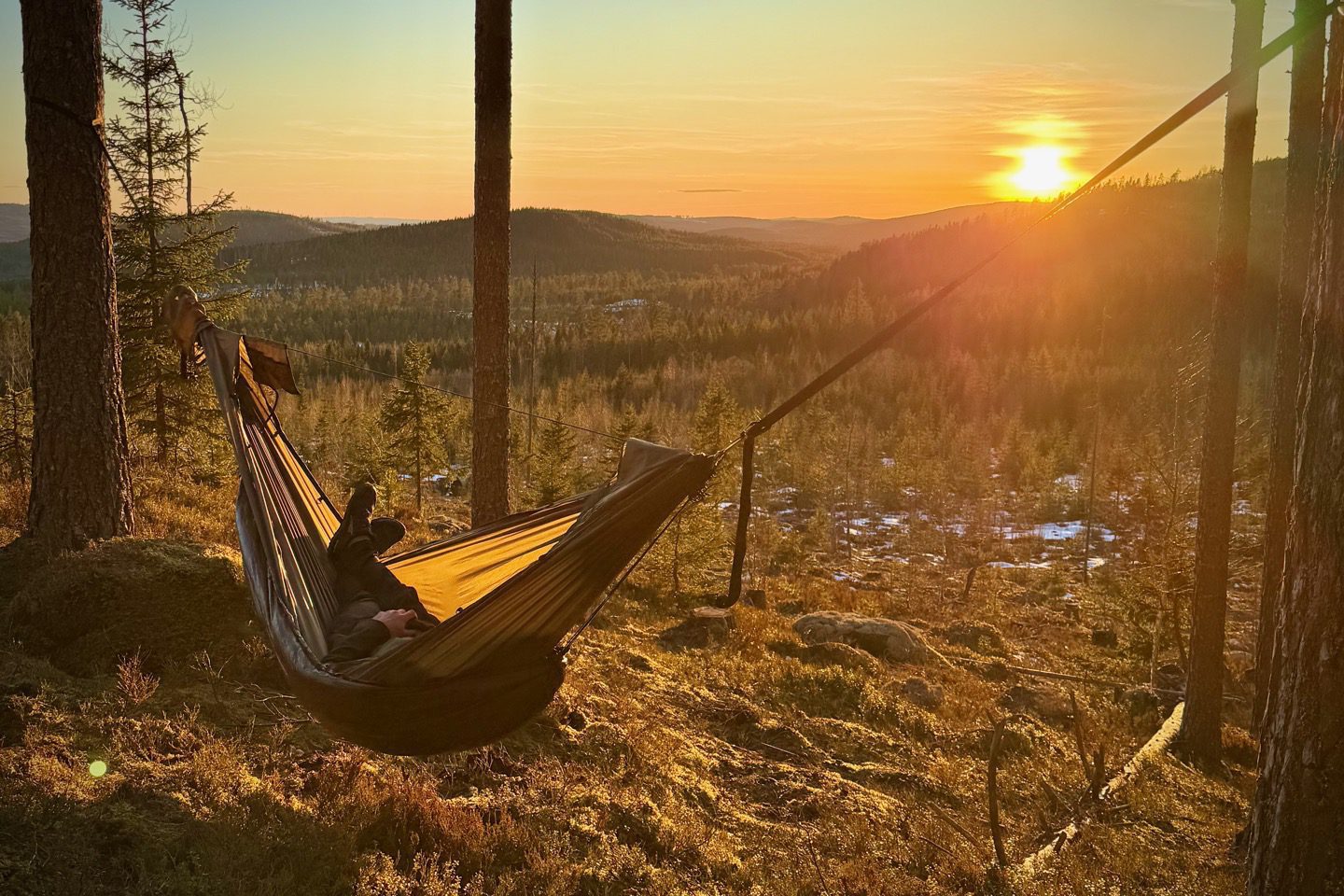Most winter hammock problems come from only one thing:
people think warmth is built above them.
But in deep Scandinavian cold, warmth is controlled under you.
That’s what an underquilt is.
It’s not an accessory.
It’s the foundation of your night.
This article will give you the exact mental model you need to choose the right one — not based on marketing, but on physics + Nordic conditions.
And when you have the right underquilt, winter hammock camping becomes what it is for us Scandinavians:
calm.
Warmth in winter hammocking is a fight against cold air movement
Tents have ground contact.
Hammocks have air contact.
And moving air under your hammock is the most unforgiving heat thief in the whole outdoors. The sleeping bag cannot stop that — because a sleeping bag compresses under your body weight and loses loft → meaning warm trapped air escapes.
High loft below you is the secret.
That’s why Scandinavian winter hammocking is not about a “better sleeping bag” — it’s about underquilt discipline.
The 3 categories that matter when choosing an underquilt
Forget “brand”.
Forget advertising words.
You only evaluate 3 things:
- Loft
- Fit / Geometry
- Adjustment tolerance
1) Loft
Higher loft traps more air per gram. That’s real warmth.
Down → best warmth-to-weight ratio.
2) Fit / Geometry
A winter quilt needs full body coverage without gaps.
If the underquilt doesn’t match the hammock length or shape → you will get cold shoulders or cold calves.
(This is the mistake 90% of people make: they buy “a quilt” — but not “their quilt”.)
3) Adjustment tolerance
Winter setups need micro-adjustments.
You don’t want to fight cold spots at 02:47 in the dark.
The quilt should “auto seal” around you without precision work.
Nordic-specific factors you should consider (this is where non-Scandinavians go wrong)
Moisture
We have “wet cold”, especially coastal and southern Sweden / Norway.
Down quality + shell fabric matters more here than deep Arctic dry cold.
Wind direction
The right tarp pitch angle can gain you 5–15°C perceived warmth.
Pack size & storage
Winter gear is heavier in general.
A good underquilt saves weight in other packing categories.
Why Scandinavians often choose an underquilt before anything else
Here is the typical progression of winter hangers who get serious:
- buy random gear
- freeze → assume “winter hammocking sucks”
- fix their UNDERQUILT → winter becomes heaven
For many of us in the North, underquilt is the FIRST winter item that is “non-negotiable”.
recommended sequence for winter hammock system
If you want a simple clear upgrading order:
- Underquilt
- Top Quilt
- Asym tarp (smaller) or big tarp (storm mode)
Those 3 items create 80–90% of comfort outcomes.
- Underquilt: https://jordhammock.com/underquilt/
- Topquilt: https://jordhammock.com/topquilt/
- Hammock: https://jordhammock.com/hammock/
- Full Kit: https://jordhammock.com/hammock-kit/
mistakes to avoid
Buying for “temperature rating” only
Numbers are not truth — loft + fit = truth.
Trying to “cheat” with pads
Pads are fine in shoulder season, but in Nordic winter they are unpredictable and uncomfortable.
Going cheap because “you only camp a few nights”
This is backwards thinking:
good gear → you camp more nights → you get more life out of winter.
Why a good underquilt creates confidence
Winter hammock hanging is not about ego.
It is about:
- calm
- predictable warmth
- low stress setup
- effortless mornings
When you choose the right underquilt, your mind stops “calculating survival” and starts fully entering the forest.
This is why winter hammock camping becomes addictive.
Take your next step
If you’re new, start here:
→ Scandinavian winter hammock camping guide
https://jordhammock.com/blog/scandinavian-winter-hammock-camping/
That article is your cornerstone.
It gives you the mental base.
Then choose your underquilt based on the principles above.
Prioritise loft, geometry and tolerance — not slogans.
And welcome to the winter forest.
Become the person who sleeps above the snow, not in it.

